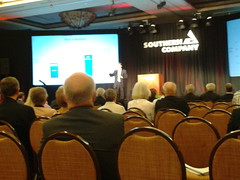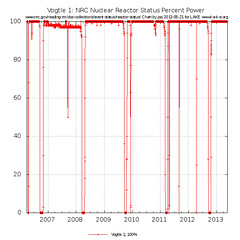 Here’s
Southern Company’s own video
of the
22 May 2013 shareholders meeting.
More detail will follow on the record number of questions,
and CEO Tom Fanning’s answers, in addition to this one already posted.
Here’s
Southern Company’s own video
of the
22 May 2013 shareholders meeting.
More detail will follow on the record number of questions,
and CEO Tom Fanning’s answers, in addition to this one already posted.
-jsq
 Here’s
Southern Company’s own video
of the
22 May 2013 shareholders meeting.
More detail will follow on the record number of questions,
and CEO Tom Fanning’s answers, in addition to this one already posted.
Here’s
Southern Company’s own video
of the
22 May 2013 shareholders meeting.
More detail will follow on the record number of questions,
and CEO Tom Fanning’s answers, in addition to this one already posted.
-jsq
Explosions in Tilbury, England, explosions in Waycross: south Georgia wood pellet dust blowing up here and there and producing CO2 when burned there. Why is “the world’s largest wood pellet plant” a better use of Georgia foresters’ resources than solar farms, which don’t pollute and don’t explode?

A massive fire raged inside wood pellet silos for RWE’s Tilbury Power Station in Essex, UK, on February 27, 2012. The biomass incinerator—the largest in the world at 750 megawatts—had just been converted from coal to woody biomass a month earlier. RWE claims no single cause can be attributed to the fire, but suspects that smoldering wood pellets triggered the dust fire.
 In a recent editorial (apparently not online),
Robert Farris
Executive Director of the
Georgia Forestry Commission,
wrote that Georgia has nine wood pellet plants.
He didn’t name them, but
Biomass Magazine has
a list of U.S. wood pellet plants,
including these in Georgia (I added the City column): Continue reading
In a recent editorial (apparently not online),
Robert Farris
Executive Director of the
Georgia Forestry Commission,
wrote that Georgia has nine wood pellet plants.
He didn’t name them, but
Biomass Magazine has
a list of U.S. wood pellet plants,
including these in Georgia (I added the City column): Continue reading
 Maybe Southern Company and Georgia Power should listen to Urenco’s owners:
the nuclear industry is flatlining after Fukushima.
Maybe Southern Company and Georgia Power should listen to Urenco’s owners:
the nuclear industry is flatlining after Fukushima.
Stanley Reed wrote for Dealbook.Nytimes.com 27 May 2013, Powerhouse of the Uranium Enrichment Industry Seeks an Exit,
Continue readingThe company that operates this uranium enrichment center, Urenco, is the world leader in the field. It is also plumply profitable. So why are its owners eager to sell it?
The answer, as with many things involving nuclear power, is a combination of economics, geopolitics and the Promethean prospect of an energy source that is as potentially green and abundant as deadly dangerous….
 If China implements a carbon tax, will Georgia Power CEO Paul Bowers
change his recent answer to a question about a carbon tax,
which was “why would anyone want that?”
If China implements a carbon tax, will Georgia Power CEO Paul Bowers
change his recent answer to a question about a carbon tax,
which was “why would anyone want that?”
 In February
the Chinese Ministry of Finance (MoF) said China would soon tax
carbon dioxide (CO2) emissions,
and that’s getting closer in
the country whose capital Beijing has smog bad it’s literally off the charts.
Katie Valentine wrote for ThinkProgress 22 May 2013,
Bombshell: China May Be Close To Implementing A Cap On Carbon Pollution,
In February
the Chinese Ministry of Finance (MoF) said China would soon tax
carbon dioxide (CO2) emissions,
and that’s getting closer in
the country whose capital Beijing has smog bad it’s literally off the charts.
Katie Valentine wrote for ThinkProgress 22 May 2013,
Bombshell: China May Be Close To Implementing A Cap On Carbon Pollution,
Continue readingChina is taking steps to tackle its huge carbon output. Today, the country announced the details of its first carbon trading program, which will begin in the city of Shenzhen next month. The southern city is one of seven cities and provinces, including Beijing, which will take part in the pilot program, set to be completely implemented by 2014.
And according to one local news source, China could implement an absolute, nation-wide cap on its carbon emissions by 2016. China’s 21st Century Business Herald reported this week that the country’s State Council still needs to approve the carbon cap proposal submitted by the National Development and Reform Commission, a government entity that controls much of the Chinese economy. The proposal, which the State Council is reportedly likely to support, would ensure China’s emissions would not increase past the country’s target cap, regardless of economic growth — though it’s still unclear what that cap would be. The paper reported that the NDRC also predicts China’s greenhouse gas emissions will peak in 2025, rather than 2030, as earlier predictions stated.
If the cap is adopted,
 Southern Company gets substantial profits from utility customers paying in advance
for “clean coal” in Kemper County, MS and for new nukes at Plant Vogtle
on the Savannah River in Georgia.
As long as SO can keep raking in those profits, it has incentive
not to get on with distributed solar power.
Southern Company gets substantial profits from utility customers paying in advance
for “clean coal” in Kemper County, MS and for new nukes at Plant Vogtle
on the Savannah River in Georgia.
As long as SO can keep raking in those profits, it has incentive
not to get on with distributed solar power.
Kristi E. Swartz wrote for the AJC 27 July 2011, Southern Co.’s profits up on nuke finance fees,
A fee added to Georgia Power bills to help finance a planned nuclear plant expansion also helped parent Southern Co. post an 18 percent profit gain in the second quarter.
The $3.73 monthly fee offsets financing costs for two proposed nuclear reactors at Plant Vogtle.
Atlanta-based Southern cited it as one of the factors lifting net income to $603.3 million, or 71 cents a share, in the April-June quarter compared with $510.2 million, or 62 cents a share a year earlier. Profits were also helped by a hot early summer, the company said.
Back then SO CEO Tom Fanning said,
“The whole issue is to preserve schedule and costs,” Fanning said.Continue reading
 “Corporate responsiblity,” answered Southern Company CEO Thomas A. Fanning
to questions about Kemper Coal from Linda St. Martin of Mississippians
For Affordable Energy.
I don’t think that word means what he thinks it means.
“Corporate responsiblity,” answered Southern Company CEO Thomas A. Fanning
to questions about Kemper Coal from Linda St. Martin of Mississippians
For Affordable Energy.
I don’t think that word means what he thinks it means.
Ray Henry wrote for AP yesterday, Southern Co. CEO defends Miss. power project,
Continue reading“Almost like a Berkshire-Hathaway meeting,” remarked SO CEO Tom Fanning after Sierra Club (and other) activists asked questions at the Southern Company stockholder meeting at Callaway Gardens yesterday, as promised by the numerous news stories the previous day after the press conference organized by Georgia Sierra Club Director Colleen Kiernan. As usual Fanning turned in a Class A CEO performance, although he seemed bemused by the diversity and sometimes very positive slant of the questions, which nonetheless brought up numerous problems with SO’s coal and nuclear agenda, lackluster renewable energy agenda, and the impending disruption of distributed solar power.
New rule this year: no unauthorized video or flash photography,
posted on big signs outside the conference room door.
 I asked Georgia Power CEO Paul Bowers to authorize me,
but he said it was a shareholder meeting and thus a different level.
The person in charge of SO’s own videoing promised they’d
be available on the web soon after the meeting.
I told him I’d been checking since last year’s meeting, and those
still weren’t on the web.
He said they had been briefly; then they were taken down.
But he would make them available.
We’ll see….
Meanwhile, you only get this one picture of Tom Fanning
(he insists everyone call him Tom) as he compared SO’s stock price to the only more stable company:
Hormel.
That’s right, SO is almost as stable as Spam.
He looked at me rather pointedly as he announced that new rule.
And rather wryly later when I pointed out
that according to Edison Electric Institute
SO’s business model was due for disruption very soon.
More on that later,
along with other reports on Wednesday’s meeting.
I asked Georgia Power CEO Paul Bowers to authorize me,
but he said it was a shareholder meeting and thus a different level.
The person in charge of SO’s own videoing promised they’d
be available on the web soon after the meeting.
I told him I’d been checking since last year’s meeting, and those
still weren’t on the web.
He said they had been briefly; then they were taken down.
But he would make them available.
We’ll see….
Meanwhile, you only get this one picture of Tom Fanning
(he insists everyone call him Tom) as he compared SO’s stock price to the only more stable company:
Hormel.
That’s right, SO is almost as stable as Spam.
He looked at me rather pointedly as he announced that new rule.
And rather wryly later when I pointed out
that according to Edison Electric Institute
SO’s business model was due for disruption very soon.
More on that later,
along with other reports on Wednesday’s meeting.
Walter C. Jones wrote for Morris News Service 21 May 2013, Southern Co. expects to face environmental challenges,
Continue readingDo nuclear reactors really deliver dependable baseload capacity? I hear industry execs say 99.99% uptime. The real average from seven years of NRC data for 104 reactors is 88.13%.
 According to Power Reactor Status Reports
posted online by the Nuclear Regulatory Commission,
here are the actual percent power percentages over time
for the 104 listed nuclear power reactors.
The timeframe is 31 March 2006 through today, 21 May 2013.
(The NRC data appears to go back to 1999, but seven years
is a good sample to start with.)
The computation for each reactor is the sum of the uptime
percentages for each day divided by the number of days.
The total uptime is the sum of the reactor uptimes divided
by the number of reactors.
Here’s the list, sorted two ways:
According to Power Reactor Status Reports
posted online by the Nuclear Regulatory Commission,
here are the actual percent power percentages over time
for the 104 listed nuclear power reactors.
The timeframe is 31 March 2006 through today, 21 May 2013.
(The NRC data appears to go back to 1999, but seven years
is a good sample to start with.)
The computation for each reactor is the sum of the uptime
percentages for each day divided by the number of days.
The total uptime is the sum of the reactor uptimes divided
by the number of reactors.
Here’s the list, sorted two ways:
Names of projects!
 Lists of PR and marketing items!
Is this a new trend from our Industrial Authority?
Or will it be like
the last time I complimented them on an agenda with content
and was told later that one was an accident.
Lists of PR and marketing items!
Is this a new trend from our Industrial Authority?
Or will it be like
the last time I complimented them on an agenda with content
and was told later that one was an accident.
Here’s the agenda. Sure, the project names are codewords, but that’s how they talk to prospective companies without revealing all their cards to the competition. And this one has a name:
 Georgia Power Company Advanced Solar Initiaitve (GPASI) Projects
Georgia Power Company Advanced Solar Initiaitve (GPASI) Projects
Maybe we’ll hear more about those two megawatts of solar power. Maybe even more are scheduled for Lowndes County.
Valdosta-Lowndes County Industrial AuthorityContinue reading
Agenda, Tuesday, May 21, 2013 5:30 p.m.
Industrial Authority Conference Room
2110 N. Patterson Street
 The applications are in their Commissioner packets,
and you don’t get to see them.
The applications are in their Commissioner packets,
and you don’t get to see them.
The other of two applicants showed up to speak at the Lowndes County Commission Regular Session 14 May 2013. Chairman Bill Slaughter said:
Commissioners in your packets you should see applications from two potential appointees. You’ve had a chance to review those.
The public, as usual, did not see those applications. Nor do I recall seeing a list from the county of available appointments. At least we sometimes get to see the applicants speak, which, if I recall correctly, was Joyce Evans’ idea.
I believe we had an opportunity to hear from Mr. Sykes yesterday; is that correct. The other applicant is Mr. Kevin McCraney. I think at this time I’d like to call on Mr. McCraney if he’d like to come forward and make a statement.
Here is
video of Jeff Sykes the previous morning.
 At the Tuesday Regular Session,
Kevin McCraney said Continue reading
At the Tuesday Regular Session,
Kevin McCraney said Continue reading